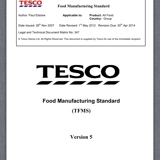Information
-
Document No.
-
Audit Title
-
Client / Site
-
Conducted on
-
Prepared by
-
Location
-
Personnel
25.1 - COMPLAINTS PROCEDURE (BASE)
-
A complaints policy and procedure to handle complaints must be in place.
-
This must be part of or linked to the site incident management procedures where necessary
-
WGLL - A certain number of complaints linked by complaint type, product or production line will trigger a review
25.2 - COMPLAINTS PROCEDURE (BASE)
-
Complaints from all sources must be covered in the procedure eg:
-
Customer representatives
-
Stores
-
Central buying department
-
Retailer customer complaints departments
-
Law enforcement bodies
-
Internal departments (eg. Operational departments)
-
Output from quality assurance processes eg. Taste panels
25.3 - COMPLAINT HANDLING (BASE)
-
Complaints from all methods of reporting (eg post, telephone, email) must be captured on a logging system
-
Each complaint must have a unique reference number
-
WGLL - complaint log includes:
-
Nature of complaint (WGLL)
-
Product information (WGLL)
-
Durability (WGLL)
-
Whether product sample has been requested (WGLL)
-
Outcome (WGLL)
25.4 - COMPLAINT HANDLING (BASE)
-
All complaints must be investigated in detail by competent personnel
-
The investigation must determine whether the complaint is product specific or an issue which may affect more than one product
-
The complaint handling procedure must identify what information to check depending on complaint type
-
Compliant types can include examples such as: foreign bodies, alleged illness, taste, quality, correct quantity etc.
-
Full records must be kept and the outcome of the investigation promptly reported to relevant personnel and departments
-
Corrective actions must be effective to prevent a reoccurrence
-
Where requested the full or reactive actions must be reported to Tesco
-
WGLL - all instances of FB contamination, alleged illness and trends need to be investigated. Isolated incidences where a customer doesn't like taste / quality perception issue may not require a full investigation, however they do need to be monitored
25.5 - COMPLAINT MONITORING (BASE)
-
Complaint trends must be monitored
-
Complaint numbers must be tracked against units sold and complaint type
-
An increase in complaints must prompt an investigation
-
The site must set targets and have a plan in place to reduce complaint levels in general and for worst offending categories / products.
25.6 - TREND ANALYSIS (BASE)
-
Information rom trend analysis of complaints must be communicated to the site management and production teams
25.6.1 - TREND ANALYSIS (ASPIRATIONAL)
-
Complaint trend information. Is graphically displayed on suitable notice boards at site access points
-
Complaint examples may also be displayed to increase awareness eg. Foreign bodies
-
Mechanisms are in place for briefing and discussing preventative action with production teams
25.7 - PRODUCT WITHRAWAL (BASE)
-
If a withdrawal / recall is required the customer must be notified using the incident management procedures.














